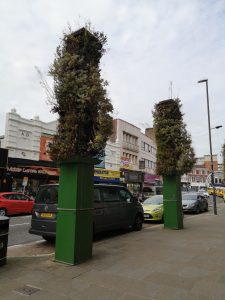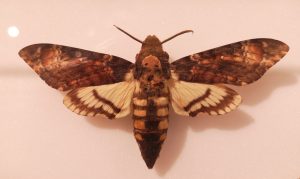Camouflage Trees
At the start of the residency, I was really interested in the huge tree planters that line the street on my way from the railway station to Artcore’s Albert Street premises. These seemed to look like camouflage trees – artificial trees used in warfare to hide gun posts and look outs. The Imperial War Museum has a fascinating collection of photographs of such trees.

A canvas and steel tree observation post. Near Souchez, 15 May 1918
© IWM (Q 10310)
Photograph taken by McLellan, David (Second Lieutenant) in 1918 during the First World War
https://www.iwm.org.uk/collections/item/object/205091320
A model of a sectioned observation post with an artillery observer. The tower is disguised as a tree

© IWM Q 31465
Photographer: Nicholls, Horace
https://www.iwm.org.uk/collections/item/object/205133247
Moths
Another object from Derby that prompted initial thoughts was the Death’s-Head Hawk-Moth in Derby Museum and Art Gallery. The moth is often seen as a symbol of evil or bad fortune as its thorax has what some consider to be a skull on it. Despite its use in mythology and popular culture, it is an excellent specimen to illustrate camouflage. When in 1889 Van Gogh depicted a ‘death’s-head moth’ (a Hawkmoth), (Van Gogh Museum, 2022), it was in fact, a Giant Peacock Moth, which is ironic considering how certain insects use mimicry.
https://www.derbymuseums.org/collection/notice-nature-feel-joy/
Lepidopterans are especially good at camouflage and mimicry as they are relatively flat. As the zoologist, camouflage expert and illustrator Hugh Cott said:
The artist, by skilful use of light and shade, creates upon a flat surface the illusionary appearance of solidity: nature on the other hand, by the precise use of countershading, creates upon a rounded surface the illusory appearance of flatness. The one makes something unreal recognizable: the other makes something unrecognizable (Cott in Forbes, 2009, p.73)

Photograph by Rachel Magdeburg of a Death’s-Head Hawk-Moth in Derby Museum & Art Gallery
